Wimmera Rice-flower
Wimmera Rice-flowerPimelea spinescens subsp. pubiflora | |
|---|---|
| Kingdom: | Plantae |
| Phylum: | Magnoliophyta |
| Class: | Magnoliopsida |
| Order: | Malvales |
| Family: | Thymelaeaceae |
| Status | |
| Australia: | Critically endangered (EPBC Act 1999) |
| Victoria: | Critically endangered (FFG Act 1988) |
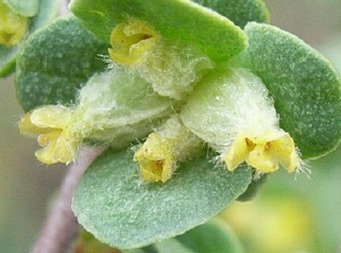
The Wimmera Rice-flower Pimelea spinescens subsp. pubiflora is a small shrub 5-50cm tall which occurs on Buloke grasslands in the Wimmera region of Victoria. Until recently it was presumed to be extinct having last been recorded from the Dimboola and Borung districts in 1901 however, rediscovery of this species occurred in Spring 2005 when a population was discovered on a roadside in the Natimuk area. Since rediscovery of this species in 2005, four other populations have been discovered; Minyip 2007, Kalkee 2016, Longerenong 2020 and Salisbury/Kiata 2021.
There are two related sub-species of Pimelea spinescens both considered Critically Endangered and Listed under the Commonwealth EPBC Act 1999 and Victorian FFG Act 1988):
-
Spiny Rice-flower Pimelea spinescens subsp. spinescens (found mainly on the Volcanic Plains in western Victoria)
-
Wimmera Rice-flower Pimelea spinescens subsp. pubiflora (currently found at five locations in the Wimmera)
Description
The flowers are critical in distinguishing the two subspecies. The Wimmera Rice-flower has flowers that are hairy on the outer surface whereas those of the Spiny Rice-flower are quite hairless. The spine-tipped nature of the stems distinguishes both the Wimmera and Spiny Rice-flower from all other Rice-flower species.
The leaves are oval shaped and are generally no bigger than 10 mm long x 3 mm wide. In contrast to most other grassland species, Wimmera Rice-flower typically blooms in mid winter. Between April and August, small creamy yellow flowers bloom profusely amongst the green leaves. As Wimmera Rice-flower blooms during the winter months, it is easy to spot amongst its surrounding vegetation.
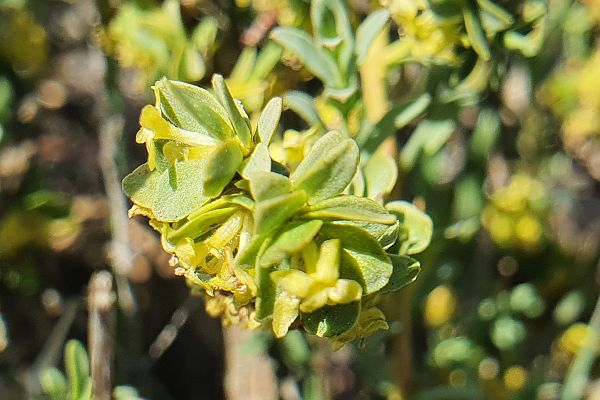
During the summer months, the green or grey-green foliage may fade slightly or partially die back depending on the rainfall. However, the small green shrub can still be seen amongst the drier grasses and weed species.
Distribution
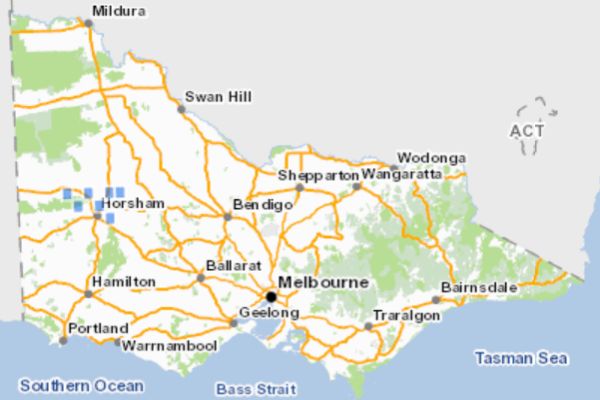
Key Local Government Areas
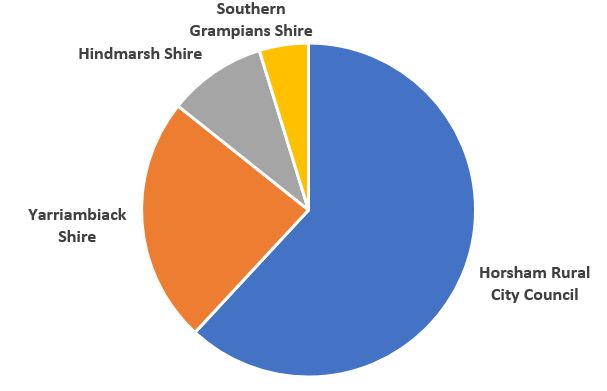
Current Wimmera Rice-flower populations
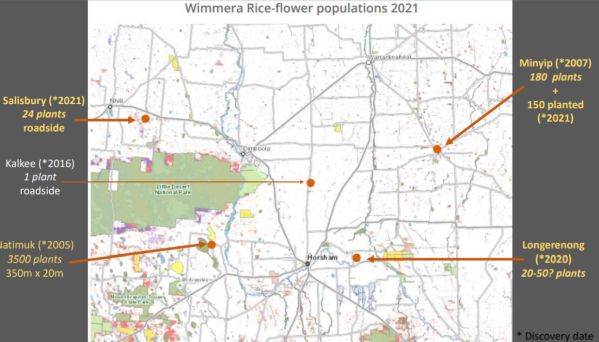
Natimuk: Population discovered in 2005. Until then species was thought to be extinct. This is the largest population of the species with about 3500 plants. Located on a roadside near Natimuk, the site covers an area of approximately 250 m x 20m and is a floristically diverse habitat that is relatively weed-free.
Minyip: Population discovered in Minyip in 2007. This site consists of around 180 individual plants scattered across 10 ha of Crown Land. In August 2021, almost 150 seedlings were planted into this site, boosting population numbers. This was the first time the species has successfully been germinated from seed and planted into an existing population. There are significant weed issues (mainly Wild Oats) across the site.
Kalkee: This site contains a single plant on a roadside in Kalkee which was discovered in 2016.
Longerenong: This population was discovered in 2020 on a Trust for Nature covenanted private property near Longerenong. A site assessment to determine plant numbers, threats and the surrounding native species assemblage is yet to be conducted but it is estimated there are 20-50 plants.
Salisbury/Kiata: New population of 24 plants discovered in September 2021. The plants are located along a roadside in the Salisbury/Kiata area.
Ecology & Habitat
Wimmera Rice-flower is found in the Ecological Vegetation Class of Plains Savannah (EVC 826). The Natimuk population occurs on reddish sandy loam with fairly abundant limestone nodules in high quality grassland dominated by native Speargrasses Austrostipa and Wallaby grasses Austrodanthonia, with scattered shrubs of Sweet Bursaria Bursaria spinosa and Cassia Senna artemisioides.
The Minyip population occurs on grey clay loam soils in a modified grass and herbaceous layer of reduced native diversity and includes annual and perennial weed species.
The Minyip and Natimuk populatins contain Buloke Trees Allocasaurina leuhmannii, many Wimmera Rice-flower plants are found at the base of these trees.
The Wimmera Rice-flower is thought to be slow growing and long-lived with plants reaching ages of up to 100 years (Mueck 2000).
Flowering occurs in mid-winter (April - August), in contrast to most other grassland species, with a profusion of small creamy yellow flowers.
Rice-shaped fruit develop mid to late Spring, they are firm, dry, nut-like structures about 3 mm long.
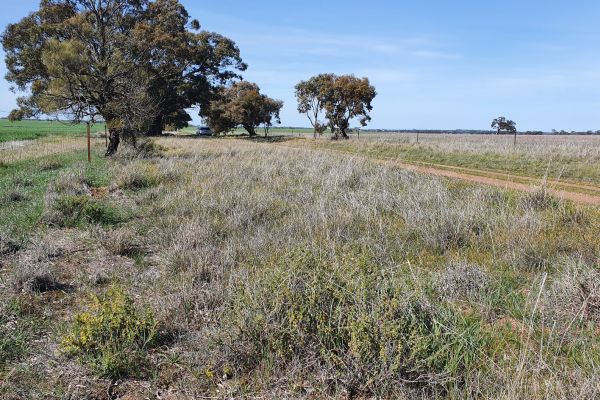
Threats
The decline of Wimmera Rice-flower is a direct result of habitat loss. To help maintain the current population size of the species it is best to avoid the following practices in areas containing Wimmera Rice-flower:
- Works and maintenance – including roadworks, firebreaks and utility installations.
- Herbicide use – Wimmera Rice-flower is sensitive to herbicides that may be applied to control neighbouring weed species.
- Soil Disturbance by mechanical intervention may also be destructive if rootstocks are uprooted or displaced.
- Inappropriate grazing – naturally these plants would have been subject to grazing by native herbivores (mainly Grey Kangaroos). At present, it is not fully understood what practices most nearly approximate this type of grazing.
- Inappropriate fire regime – the effects of fire are unknown.
- Spread of weeds – weeds take up space that might otherwise be colonised by Wimmera Rice-flower seedlings and they compete with other members of the native grassland community for nutrients etc. As all known populations of Wimmera Rice-flower occur in largely agricultural areas, any disturbance of the soil creates bare patches that will be quickly colonised by weeds.
- Reduction in population size - given that the flowers (and sometimes whole plants) are unisexual there needs to be a large enough population to ensure sufficient male and female plants are present for successful reproduction and genetic diversity. Monitoring over several years indicates both populations consist of relatively mature plants with only low levels of recruitment observed (Rudolph 2017).
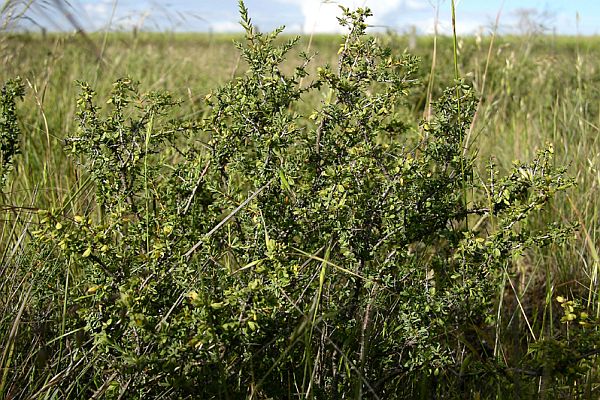
Conservation of Wimmera Rice-flower
Recovery work on this species begun in 2005 following its rediscovery. Meetings with key land managers were held on site to discuss the short and long-term management requirements for the population. These have included neighbouring landholders, and representatives from the Department of Environment, Land, Water & Planning (DELWP), Royal Botanic Gardens Melbourne, Parks Victoria, local Shire, Country Fire Authority, and the Australian Native Plants Society.
Other actions which have been implemented by DELWP include searching for new populations, identifying potential habitat, liaison with stakeholders, propagation of plants, establishment of a seed bank collection and monitoring to increase understanding of the species. These will eventually form part of the Recovery Plan.
The Natimuk site in particular is also a good example of remnant grassland vegetation. Having survived the clearing and degradation that has occurred on many other roadsides, is a great example of how important it is to protect remaining native vegetation.
The Wimmera Rice-flower recovery project became part of the Wimmera Threatened Flora Project, which was funded federally by Natural Heritage Trust via the Wimmera Catchment Authority.
Partnerships
- Minyip Committee of Management
- Minyip Progress Association
- Wimmera Catchment Management Authority
- Department of Environment, Land, Water & Planning (Horsham)
- Horsham Rural City Council
- Yarriambiack Shire
- Royal Botanic Gardens
Management progress
Monitoring & surveys
Since rediscovery of Wimmera Rice-flower in 2005 the known populations have been surveyed every year to check their health and identify any threats. (Between 2009 to 2010 monitoring of the five 1 x 1 m quadrates at the Natimuk population didn’t detect any germinants and showed a small loss of 5 plants).
Surveys of surrounding roadsides and other potentially suitable areas have been conducted every year between 2006 to 2021, four new populations have been discovered ( see above).
Research, translocation and plantings
Since 2005, seed has been collected on a regular basis from all populations to facilitate propagation of plants for reintroduction. In 2021, seed was collected from the most recently discovered site at Salisbury/Kiata which adds to the genetics stored at the Royal Botanic Garden seed bank.
A translocation plan has been developed which includes potential translocation sites.
Trials of in-situ germination from seeds has been trialled with limited success. Results indicate successful germination may not occur in the first 2-3 years. This species seems to be very reliant on successive good years of autumn rainfall for good seed germination and survival.
The Royal Botanic Gardens has conducted research into seed germination requirements by conducting laboratory and field trials. Smokey water treatment appears to improve germination success rates.
The Royal Botanic Gardens completed a genetic diversity study in 2013.
In August 2021, almost 150 Wimmera Rice-flower seedlings produced by Victoria University were planted into an existing site in Minyip to increase the population size and genetic diversity.
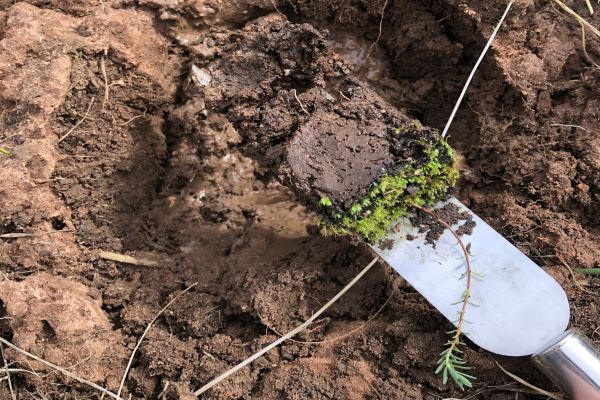
.jpg)
Site management
Burning
The possibility of undertaking a strategic burn through part of Natimuk population has been looked at as a method of weed control and stimulus to seedling germination. Further consideration is required by recovery partners.
An autumn ecological burn was conducted at the Minyip site in Autumn 2009 to try and reduce wild oats. Pimelea was recorded re-sprouting following the burn. A seed trial using a variety of treatments was conducted to investigate the effectiveness of the 2009 ecological burn in germinating seed. There was no positive germinants observed from this trial.
Weed control
Horsham Rural City Council undertakes control of pest plants at the Natimuk site in areas of previous disturbance.
In 2011, a Community Action Grant for $18,700 was used by the Minyip Committee of Management to control weeds and begin a Grassy Groundcover Project.
Protection of sites
Horsham Rural City Council helps to protect the Natimuk site from accidental damage caused by maintenance and roadworks through training Shire staff and works crews.
Signs have been installed at both sites to increase awareness of the need to keep vehicles and machinery out of the areas. Bollards were erected to restrict vehicles / tractors entering the Natimuk roadside site.
References & Links
- EPBC Act (1999) Environment Protection and Biodiversity Conservation Act 1999.
- FFG Act (1988) Victorian Flora and Fauna Guarantee Act 1988 (FFG Act) Flora and Fauna Guarantee Act Threatened List 2021
- Mueck, S. 2000. Translocation of Plains Rice-flower (Pimelea spinescens subsp. spinescens), Laverton, Victoria. Ecological Management & Restoration 1(2): 111–116. Wiley Online Library
- Rudolph (2017) Pers. comms. Pauline Rudolph, Department of Environment, Land, Water & Planning, (Horsham), Victoria.
- VBA (2021) Victorian Biodiversity Atlas, Department of Environment, Land, Water & Planning, Victoria.

